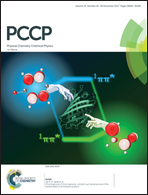Sub-Doppler infrared spectroscopy of resonance-stabilized hydrocarbon intermediates: ν3/ν4 CH stretch modes and CH2 internal rotor dynamics of benzyl radical†
Abstract
Highly reactive benzyl radicals are generated by electron dissociative attachment to benzyl chloride doped into a neon–hydrogen–helium discharge and immediately cooled to Trot = 15 K in a high density, supersonic slit expansion environment. The sub-Doppler spectra are fit to an asymmetric-top rotational Hamiltonian, thereby yielding spectroscopic constants for the ground (v = 0) and first excited (v = 1, ν3, ν4) vibrational levels of the ground electronic state. The rotational constants obtained for the ground state are in good agreement with previous laser induced fluorescence measurements (LIF), with vibrational band origins (ν3 = 3073.2350 ± 0.0006 cm−1, ν4 = 3067.0576 ± 0.0006 cm−1) in agreement with anharmonically corrected density functional theory calculations. To assist in detection of benzyl radical in the interstellar medium, we have also significantly improved the precision of the ground state rotational constants through combined analysis of the ground state IR and LIF combination differences. Of dynamical interest, there is no evidence in the sub-Doppler spectra for tunneling splittings due to internal rotation of the CH2 methylene subunit, which implies a significant rotational barrier consistent with partial double bond character in the CC bond. This is further confirmed with high level ab initio calculations at the CCSD(T)-f12b/ccpVdZ-f12 level, which predict a zero-point energy corrected barrier to internal rotation of ΔEtun ≈ 11.45 kcal mol−1 or 4005 cm−1. In summary, the high-resolution infrared spectra are in excellent agreement with simple physical organic chemistry pictures of a strongly resonance-stabilized benzyl radical with a nearly rigid planar structure due to electron delocalization around the aromatic ring.

- This article is part of the themed collection: 2017 PCCP HOT Articles


 Please wait while we load your content...
Please wait while we load your content...